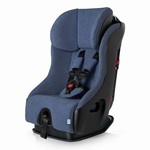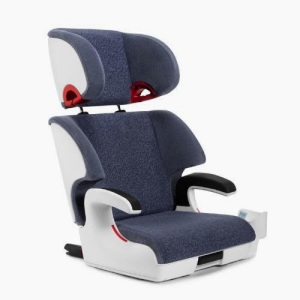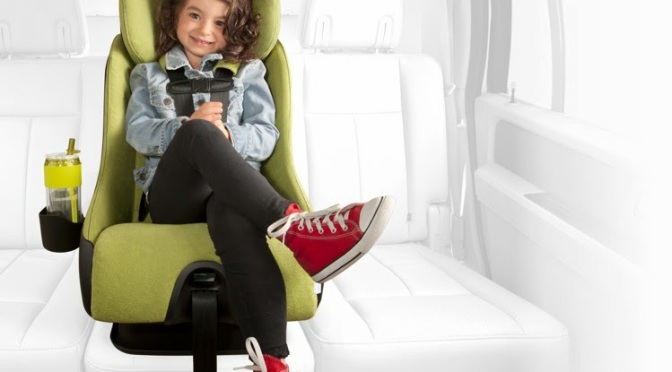 If you’re into car safety, child safety, and reviewing recommended car seats the way I am, it’s easy to come up with reasons to buy a new car seat. Similarly, if you’ve ever seen the damage that can occur to children or adults who aren’t properly restrained in a car crash, or, alternatively, if you’ve seen how properly-restrained children can survive unimaginably horrible car accidents (see the orphan seat phenomenon), you already know that new car seats are a good idea.
If you’re into car safety, child safety, and reviewing recommended car seats the way I am, it’s easy to come up with reasons to buy a new car seat. Similarly, if you’ve ever seen the damage that can occur to children or adults who aren’t properly restrained in a car crash, or, alternatively, if you’ve seen how properly-restrained children can survive unimaginably horrible car accidents (see the orphan seat phenomenon), you already know that new car seats are a good idea.
However, if you’re like the average parent, you might have great intentions to care for your children (or grandchildren, or nieces and nephews), but might not understand exactly why there are so many rules and regulations about car seats, or what the differences are between a $30 eBay seat and a $300 seat like a Clek Fllo (pictured above) or a Britax Boulevard ClickTight, and why the latter are a much better investment in your child’s safety. This post is designed to help clarify some of these questions by working through 10 good reasons to buy a new car seat.
Top 7 Reasons to Buy a New Car Seat, with Explanations and Reviews
1. Car seats do expire, just like bicycle helmets and smoke detectors.
It’s easy to look at a car seat the way we look at a couch in the living room: something we use until it breaks down, looks frightful, or until we’re in the mood for a new one. However, a much better analogy would be to think of a car seat like a bicycle helmet or a set of tires. Bicycle helmets have a limited shelf life, which means that they eventually expire and need to be thrown away whether they were used or not, and whether they’ve ever been involved in a crash or not.
Car seats work in exactly the same way; they’re made of a combination of metal and plastic, and the plastic components break down over time. Similarly, your tires should be replaced every few years even if they look fine, and your smoke detector has an expiration date printed on the underside. Replacing your smoke detector isn’t something you’d put off to save a few dollars, and replacing your car seat is just as important when it comes to keeping your loved ones safe.
2. 2- and 3-year-olds shouldn’t be forward facing, or new seats make extended rear-facing easier
If there’s one thing I harp on in this blog it’s about the benefits of extended rear-facing, and this is simply easier when you buy one of the newer car seats on the market today compared to the older ones. The truth of the matter is that toddlers and young preschoolers like 2- and 3-year-olds have no business forward-facing, even though it’s currently perfectly legal in the United States. Children don’t forward-face in Sweden until they’re at least 4, on average, and this is a big part of why Sweden has the lowest rates of child car accident fatalities in the world.
I’ve written in several places, such as here and here, about how and why rear-facing past 2 is so important, but to make it feasible, you need car seats that rear-face until at least 40 pounds, like the Head Wise 70 or NextFit. It’s even better if you can buy one of the seats that rear-face until 50 pounds, like the Fllo, Foonf, Extend2Fit, Rainier, or Pacifica. The safety differences are worth it, and it’s worth noting that none of the seats with 50 pound rear-facing limits existed more than a handful of years ago. The Fllo, Rainier, and Pacifica just came out this year! That’s how new the technology is.
 3. 4- and 5-year-olds shouldn’t be in booster seats, or new seats make extended harnessing easier
3. 4- and 5-year-olds shouldn’t be in booster seats, or new seats make extended harnessing easier
Just as 2- and 3-year-olds shouldn’t forward-face due to their developmental vulnerabilities and the inherent safety of rear-facing, 4-and 5-year-olds shouldn’t be in booster seats, regardless of how mature they may appear to be. Instead, they should remain forward-facing as long as possible in harnessed seats, and ideally until around age 8. This is particularly striking when you think of how many 8-year-olds ride in the front seat in seat belts with their parents.
At any rate, keeping elementary-aged children in forward-facing seats and out of boosters would have been an impossibility just a few years ago with most harnessed seats on the market, simply because most of them topped out in weight and height limits too soon to make extended harnessing feasible for all but the smallest children. However, thanks to recent developments in seats like the Frontier and Pinnacle, extended harnessing is not only possible, it’s practical and comfortable.
4. 8-and 9-year olds shouldn’t use adult seat belts, or you need booster seats for longer than you think
Just as 4-and 5-year-olds aren’t ready for booster seats, 8-and 9-year-olds aren’t ready for the adult seat belt, no matter how much they may argue to the contrary. The truth is that booster seats should be used for far longer than most parents think; children typically won’t fit adult seat belt correctly and safely until they’re between 10 and around 12 years old, which means that if you’re allowing your 3rd or 4th grader to sit with you in the front or even sit in the back without a booster seat, you’d benefit from changing that for a safer seating option. Fortunately, the Frontier 90 and Pinnacle 90 not only make excellent forward-facing seats, they’re also the best on the market when it comes to boosters, which makes the buying process cheaper and simpler.
4. Car seats can’t be reused after a crash; they need to be replaced
We talked earlier about how car seats eventually expired whether or not they were used. However, if a car seat is used in its intended purpose, it definitely needs to be replaced, and it’s definitely expired. The reason here is the same as that for the bicycle helmet: you can’t always see structural damage with the naked eye. If there’s as much as a hairline fracture within the car seat, it could render it severely weakened in comparison to its designed strength, and this also applies for bicycle helmets.
5. Improvements in side impact protection, or the most vulnerable part of a car in an accident
I’ve written about all kinds of accidents and seen many more in my years on this earth, and the kinds that have always been most likely to lead to fatalities have been side impacts. There simply isn’t much material protecting you in a t-bone collision, which is why these collisions are the most likely to be fatal compared to frontal and rear impacts. With this knowledge, you want car seats that have side impact protection systems, such as those found in the Fllo, Foonf, Rainier, and Advocate ClickTight, which I think are the four best car seats for side protection available today in the United States.
6. New car seats are lighter, narrower, and easier to fit 3 across than older ones
This factor isn’t so much related to safety as it is to convenience, but if you’re anything like me, you appreciate anything that makes modern life a bit easier. And the fact is that newer car seats are lighter and narrower than ever before when compared to their height and weight capacities. Seats like the Fllo and Foonf are about as narrow as car seats get at 17 inches across, yet they can still rear-face to 50 pounds while making it possible to fit 3 car seats across in any vehicle. Check out the 3 across car seat guide to see which car seats fit in your car, minivan, SUV, or pickup truck. You might be surprised; these days, the size of your back seat doesn’t have to keep you from hauling your little ones safely.
7. New car seats are bringing new technologies like load legs and rear-facing tethering
Finally, while newer isn’t always better, it certainly is when it comes to car seat technology. For example, think about rear-facing tethering. There are only a handful of car seats that allow you to tether while rear-facing in the United States, even though rear-facing tethering does have a number of advantages in car seat safety. A few of those advantages include the ability to reduce rebound and rotational rotation, as well as the ability to limit head excursion, or the forward movement of a child’s head in a rear impact collision. These are significant features, and only seats like the Rainier, Pacifica, and a few others allow you to take advantage of them. But the number of seats that let you tether rear-facing is growing by the year, and buying newer car seats allows you to keep your children safer for longer.
In conclusion, while it might be a pain to go car seat shopping (although I hope my reviews of recommended car seats makes it easier), the truth is that you’re doing your children a favor by keeping up to date with their car seats. Car accidents are the primary killer of children in the United States, and for a few hundred dollars every 7 or 10 years, you can keep your children safer than ever. They’re worth it.
If you find the information on car safety, recommended car seats, and car seat reviews on this car seat blog helpful, you can shop through this Amazon link for any purchases, car seat-related or not. Canadians can shop through this link for Canadian purchases.


